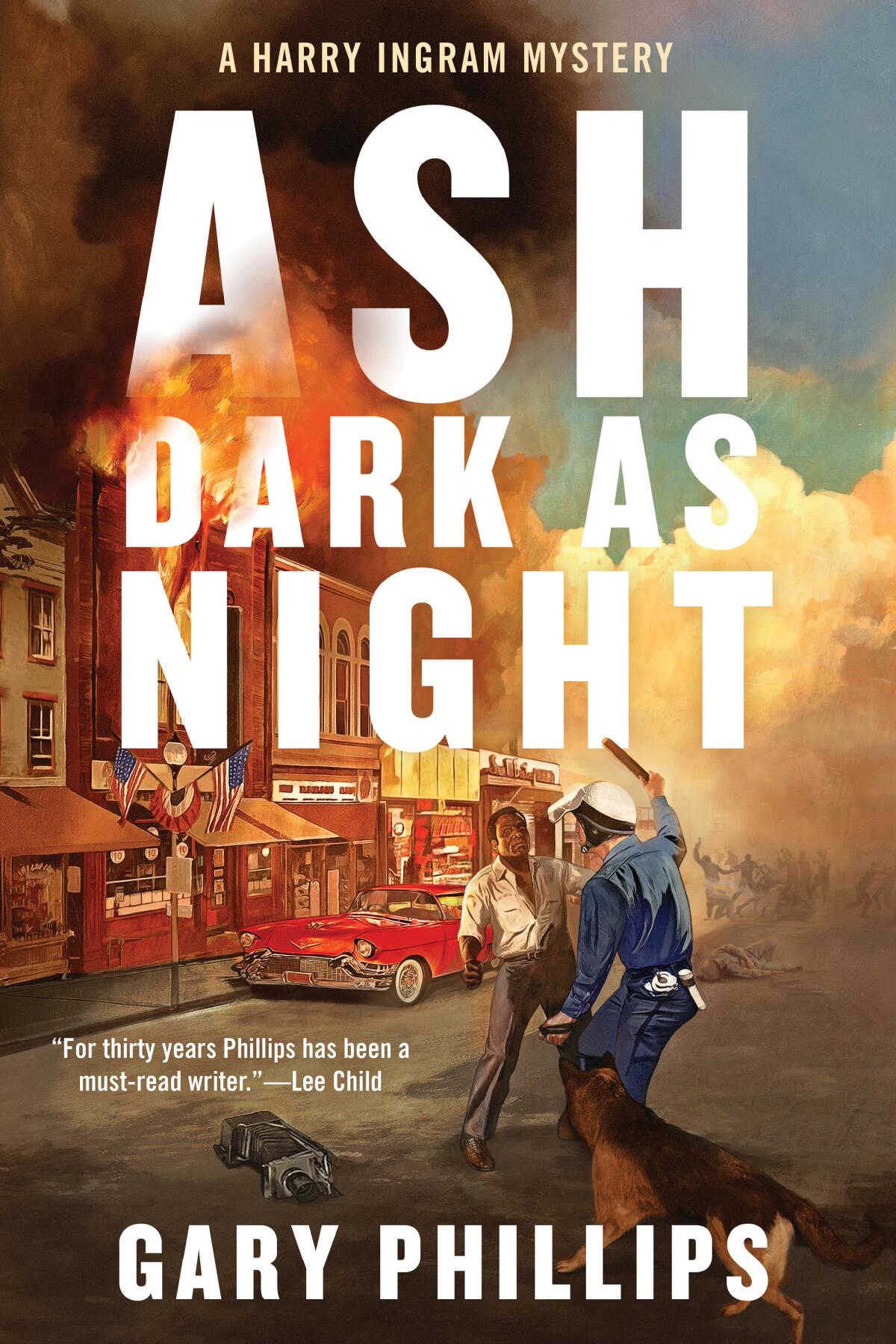Los Angeles’ mass uprisings in search of Black justice have punctuated my life, and my library

- Share via
Book review
Ash Dark as Night
By Gary Phillips
Soho Crime: 312 pages, $27.95
If you buy books linked on our site, The Times may earn a commission from Bookshop.org, whose fees support independent bookstores.
My life — and my book collection — in Los Angeles have been punctuated by mass rebellions.
For the record:
10:00 a.m. April 23, 2024An earlier version referred to “stolen orange juice” as leading to the 1991 shooting death of Latasha Harlins, a Black teenager. When the altercation began that ended with her being shot, Harlins had had money in her hand that would have covered the cost of the juice. She had not stolen it.
The most recent addition to my library is Gary Phillips’ excellent “Ash Dark as Night,” his second book featuring Harry Ingram, a Black freelance photographer and budding sleuth. It opens with Harry risking life and limb to capture the 1965 Watts riots on film, including the murder by police of a charismatic young Black organizer. The chaotic violence and police retaliation Ingram photographs in the book ignited my own memories of that period.

For example, there was the time in 1965 when my father and I were trapped in his Ford pickup on a Watts side street, between the National Guard at one end of the block and rioters, with rifles and bats visible, at the other. He had taken me with him that August morning to check on his auto parts and mechanics’ shop after several days of rebellion by Black residents responding to the violent arrest of 21-year-old Marquette Frye, allegedly for drunken driving, and rampant rumors of the beating of a pregnant woman by police in the melee. After double checking for damage on the “Soul Brother” signs he’d spray-painted on plywood at his shop, he asked me if I wanted to see the wreckage in Watts firsthand. We had talked at home about the reasons behind the riots, and my father’s anger and sorrow over the destruction of his local bank, shoe store and barbershop, all on 103rd Street, was palpable.
Most Black businesses were spared in the rioting, a point Phillips makes in “Ash Dark as Night” as Ingram checks in on his neighborhood grocer and, ironically, an auto parts store and mechanics’ shop belonging to one of his friends. Phillips’ descriptions of the utter conflagration that was Watts as well as the mysterious fictional events that follow capture the spirit of the social and political upheaval of 1960s Los Angeles with a veracity that chilled me.
Phillips is by no means the first to write about the Watts Rebellion, as it’s called by many survivors and historians, including Mike Davis and Jon Wiener in 2020’s “Set the Night on Fire: L.A. in the Sixties” and Elizabeth Hinton in 2021’s definitive “America on Fire.” Other notable fiction on my bookshelf that is set during this period includes Walter Mosley’s “Little Scarlet,” featuring Easy Rawlins’ account of the personal toll of the Watts riots. Mosley and Phillips, both youngsters when the uprising took place, use their fiction to bear witness to the rage and ambivalence of their elders about the destruction and the oppression that gave rise to it. (And for a contrasting view of the riots from the side of law enforcement, there’s Joseph Wambaugh’s 1970 classic, “The New Centurions.”)
Spring will be all about the heavy hitters. But this winter brings 4 blazing thrillers well worth your time — from a medical mystery to a racial reckoning.
By the spring of 1992, when four Los Angeles Police Department officers accused of violently assaulting Rodney King were acquitted, leading to widespread riots, I was an adult and well aware of the continued oppression of many Black and brown Angelenos, exacerbated by dual epidemics of gang warfare and drug addiction. A generation after the Watts rebellion, I found myself channeling my father’s ambivalence about the violence and sharing his anger at the opportunistic looting, which reached a supermarket near my home. But not all of 1992’s rioters were Black, nor was the damage confined to 2.5 square miles. The fires were everywhere, visible even from space. Neighborhoods across the city were touched, and much of Koreatown’s infrastructure was damaged.
Motives were also more complex, not easily explained away with the tidy description used decades earlier in the McCone Commission Report, which blamed the Watts riots on “Disintegrating Black families, who set in motion a spiral of failure for their children, dooming them to lives of crime and welfare dependency.” Social historian Davis got closer when talking to a member of the Inglewood Bloods: “This riot is about all the homeboys murdered by the police, about the little sister killed by the Koreans, about twenty-seven years of oppression,” the young man asserted, referencing not only Watts but also the 1991 voluntary manslaughter conviction and minimal sentence imposed on Soon Ja Du, a Korean immigrant and liquor store owner, for shooting and killing Latasha Harlins, a Black teenager. “Rodney King just the trigger.”
In 1993, Phillips wrote one of the first novels about that turbulent time, “Violent Spring,” to be reissued next month by Soho Press with an introduction by Mosley. I, too, turned to writing fiction to process my feelings about policing and the price paid for working in an institution whose values you no longer support: 1999’s “Inner City Blues” featured a conflicted Black female LAPD homicide detective solving a murder in the middle of the Rodney King uprising. She was one of a handful of Black law enforcement protagonists since Chester Himes’ nine Gravedigger Jones and Coffin Ed mysteries.
Steph Cha’s ‘Your House Will Pay’ confronts the legacies of the 1992 L.A. riots
More recent books critiquing the era have added much-needed perspectives on racism, civil unrest and the toll they exact from all parties. Most prescient of these is Steph Cha’s “Your House Will Pay,” a 2019 crime novel that riffs on the Harlins murder to explore how a Korean American family’s secrets are exposed, decades later, when the mother is shot, drive-by style, in front of the family’s San Fernando Valley pharmacy. Suspicion falls on an ex-con and surviving brother of a Black teen shot by a shopkeeper some 10 years before. Cha’s morally complex tale follows both the Korean and Black families and culminates in a multiracial riot that is the result of cycles of generational trauma and violence not easily broken.
“Your House Will Pay” presaged the events of just a year later when nationwide protests rolled like thunder in the aftermath of George Floyd’s murder, propelling a rainbow of humanity to demonstrate for racial justice and LGBTQ+ rights. I am just seeing the first crime fiction address the root causes of those protests. Like Cha’s novel, these early responses thrum with the complexity of other perspectives, including those who feel aggrieved by the support for the diversity, equity and inclusion that followed the Floyd demonstrations. It makes me wonder what’s to come and what books will join my collection, as subsequent generations reconsider and record the tumultuous stories of our collective struggle for liberty and justice.
A member of the National Book Critics Circle, Paula L. Woods is the editor of several anthologies and author of four novels in the Charlotte Justice mystery series.
More to Read
A cure for the common opinion
Get thought-provoking perspectives with our weekly newsletter.
You may occasionally receive promotional content from the Los Angeles Times.












